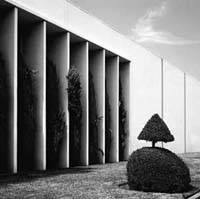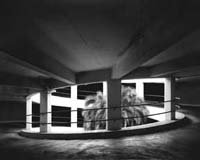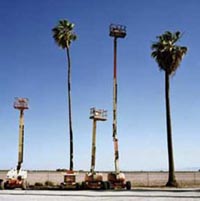|
Urban Trees Planting roots in the city Photographs by David Paul Bayles
In his early 20s, Bayles moved to the Sierra and found a job as a choker-setter on a timber crew, where he attached logs to the bulldozer that hauled them away. He ended up working in the woods for four years, gaining a deeper understanding of its inhabitants. "I had time to really look at the forest," Bayles says, "and speculate as to why this tree was bent and crooked; why that tree had limbs on only one side; why this tree had been uprooted; why that one had broken at the base." Several years later, Bayles began photographing trees. While his early images depicted their natural beauty, later pictures reflected the irony of trying to reconcile his past as a logger with his environmental beliefs. "My photographs are these tensions and confusions made real," Bayles says. "Yet they are also a reminder that we can’t live without trees. The beautiful palms, oaks, cypresses, and cedars that grace our neighborhoods shade and soothe our souls." Photographs copyright 2003 by David Paul Bayles, from Urban Forest: Images of Trees in the Human Landscape by David Paul Bayles (Sierra Club Books, 2003). Better Living Through Forestry by Sam Boykin
Some of the development’s 28 buildings were surrounded by concrete and asphalt, while others were close to common areas with trees, grass, and flowers. Of the 200 or so residents the researchers met with and observed, those who lived near the landscaped areas had better relations with their neighbors, felt a stronger sense of community, and experienced less violence in their homes. Although their findings may seem remarkable, it’s really no surprise that what Henry David Thoreau called "innocent stimulants of bright and cheering prospects" are capable of helping create better urban communities. From happier residents to higher property values, trees provide important economic, environmental, and health benefits. But increasing populations and rampant development are rapidly squeezing out urban forests. Charlotte, North Carolina, one of the ten fastest-growing big cities in the nation, lost 22 percent of its heavy tree cover between 1984 and 2001, and other metropolitan areas have experienced similar declines. In response to this dwindling "green infrastructure," many cities have enacted tough new ordinances that require a certain percent of tree cover in commercial and retail development. Thoreau couldn’t have known what our cities would be like in 2003, but he knew what they would need: "A village is not complete, unless it have these trees to mark the season in it," he wrote in 1862. "They are important, like the town clock. A village that has them not . . . has a screw loose, an essential part is wanting."
Trees help prevent flooding by intercepting raindrops on their leaves, branches, and trunks. From there, the water evaporates or slowly soaks into the ground. A healthy urban forest can reduce peak storm runoff by 10 to 20 percent. During photosynthesis, trees sequester carbon dioxide and convert it to oxygen. The average urban tree removes nearly a ton of the greenhouse gas during its first 40 years of life. One wooded acre provides enough oxygen for 18 people, and absorbs as much carbon dioxide as a car produces in 26,000 miles. Trees also clear the air of sulfur dioxide and nitrogen oxide, two major components of acid rain and ozone pollution. Trees absorb the siren wails, clanging of trash cans, and other sounds of urban life. A stand 100 feet wide and 45 feet tall can reduce noise levels by 50 percent. Trees stimulate economic development: Commercial retail areas with good tree cover are more attractive to shoppers, and draw new businesses and tourism. Likewise, apartments in a wooded setting rent more quickly and their tenants stay longer. Homeowners benefit, too: A yard landscaped with mature trees can increase the property value by as much as 20 percent.
We feel more rested and tranquil with trees around. An environmental psychologist at Texas A&M University even found that hospital patients recovered from surgery more quickly when their room offered a leafy view. A shadier city is cheaper to live in. Trees shrink demand for air conditioning, reducing the need for new power plants and helping to keep electricity rates down. By providing a windbreak, trees (especially evergreens) also help reduce individual heating bills by up to 30 percent. Using advanced satellite imagery, digital maps, and high-tech software, the conservation organization American Forests generates "Urban Ecosystem Analyses" for city officials. These reports provide guidelines on how to integrate trees into land-use decisions and new developments. (For more information, visit www.americanforests.org/resources/rea.) Explore |



